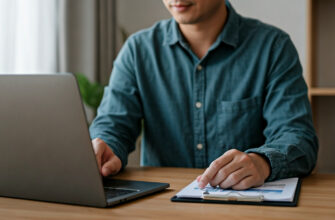If you’ve ever held a paper check in your hand and thought, “Do I really have to go to the bank for this?” — that’s exactly where mobile check deposit comes in. This feature turns your smartphone camera into a check-processing tool. You snap a photo, press a button, and poof — money on the move. But even though the process feels quick and easy, what happens behind the scenes is surprisingly layered. Not everything “just goes through,” and people are often caught off guard by delays, rejections, or app limitations they didn’t know existed. Some users don’t even see the deposit option in their app, while others get their checks held for days with no clear reason. This whole thing isn’t magic — it’s technology wrapped in bank policies, risk checks, and a few unspoken rules they don’t advertise in big print. Here’s a clear look at what mobile check deposit actually involves — beyond the screen taps and camera clicks.
- What It Is — And What It’s Not
- Quick Snapshot Of The Process
- Who Can Use Mobile Check Deposit
- Is It Safe? The Basics Of Digital Check Processing
- Deposit limits you might not know exist
- Time-of-day matters more than you think
- Why that check might “go through” but still not be available
- Subtle ways to accidentally invalidate your deposit
- Try a $5 check first, not your rent check
- Double-check your camera settings
- If your deposit is denied — here’s what to do
- If you already mailed or handed over the check physically
- For freelancers, gig workers, and birthday money collectors
- When it helps — and when it gets in the way
- Mental load and trust: Why mobile deposits feel so risky sometimes
What It Is — And What It’s Not
Mobile check deposit lets you take a picture of a paper check and upload it through your bank’s mobile app so the funds can land in your account — without stepping into a branch or finding an ATM. This IS NOT the same thing as direct deposit. Direct deposit comes straight from your employer, government, or payer electronically — no paper check involved at all.
Use mobile deposit when someone gives you an actual, old-school paper check. Think birthday money from Grandma or a freelance payment from a client who “doesn’t Zelle.” But skip it when you receive larger checks, uncertain funds, or if you’re cutting it close with bill deadlines. In those cases, a delay—even one business day—can really sting. It’s a great tool, just not a perfect one for every situation.
Quick Snapshot Of The Process
- Open your mobile banking app: Most banks have a clearly labeled option like “Deposit checks” right on the dashboard.
- Endorse the check: Don’t just sign; write “For mobile deposit only” and sometimes your bank’s name, depending on the fine print.
- Snap the front and back photos: Use a plain background, steady your hand, and follow the app cues until the image looks crisp and complete.
- Enter the dollar amount: Some apps detect it automatically, but always confirm it matches what’s written on the check.
- Choose where to deposit: Usually defaulting to checking, but savings or another eligible account might be valid too.
- Press submit and wait: You’ll usually get a confirmation message right away, but that doesn’t mean the money is fully available.
And here’s the kicker: just because it’s uploaded doesn’t mean your job’s done. Don’t crumple that paper check just yet — we’ll get into why in a bit.
Who Can Use Mobile Check Deposit
Spoiler: not everyone. Even with the same app and the same bank, one user may see the deposit button while another doesn’t. Why? Banks quietly assess your account behavior, history, and how “risky” they think the check — or the depositor — might be.
Someone with a brand-new account or prior overdrafts may not qualify right away. If your app doesn’t show the mobile deposit option, it’s not a glitch — it could be a silent no from the bank’s internal filters. These requirements aren’t always listed prominently, so it can feel frustrating if you’re essentially being limited without explanation.
Is It Safe? The Basics Of Digital Check Processing
Banks also layer in human reviews and backend audits, checking everything against a national system to prevent double deposits. And here’s some reassurance — those check images? They typically don’t get saved to your phone gallery. Most apps store them securely within the app itself or temporarily in encrypted form. As long as you’re using your bank’s official app and a secure wifi connection, the risk is low. Still, treat checks like cash until the funds really clear.
Deposit limits you might not know exist
One of the biggest surprises with mobile check deposit? The invisible fences around how much you can actually deposit. These aren’t just technical caps—they’re risk management tools wearing a friendly interface.
Different banks give different leeway, and it’s not always clear. A new checking account might only be allowed to deposit a few hundred bucks per day. An older account with a direct deposit history might get several thousand without blinking. But you often won’t see these figures shown upfront unless you go searching deep in app FAQs or get denied without warning.
If you’ve ever tried to deposit a $5,000 paycheck and got hit with a vague “transaction exceeds limit” message—yep, that’s what’s happening.
- Daily caps might hit around $2,000–$5,000 depending on your bank, account type, and whether you’ve made past deposits safely.
- Monthly caps exist too, especially on basic accounts or prepaid cards. After a few uploads, you might get blocked for the rest of the cycle.
This gets even trickier when it comes to big checks. A $10,000 side hustle payment or insurance reimbursement might show up as accepted—but behind the curtain, that’s often when manual review kicks in. The bank may ping human reviewers to scan for fraud or ask you to come into a branch. That doesn’t mean you did anything wrong. It just means you tripped a policy wire you didn’t even know was there.
Time-of-day matters more than you think
Mobile check deposit feels like it should be instant—snap, upload, and done. But the reality is somewhere between “convenient” and “too late again.”
Every bank has a daily cutoff time. If your check isn’t verified before that internal deadline—usually between 5 PM and 9 PM banking time—it’s bumped to the next business day. Even a two-minute delay can mean a night (or weekend) of waiting.
Picture this: you deposit a check at 3:59 PM and get a “processed today” message. Your sibling deposits theirs at 4:01 PM and has to wait until Tuesday. Two minutes, two different timelines.
It gets messier on non-business days. Some banks don’t process anything from Friday night through Sunday. A Saturday afternoon deposit might sit in limbo until Monday morning—or Tuesday, if there’s a holiday around. Those magical “one-day” clears? They only function when everything aligns just right: time, day, and bank.
Why that check might “go through” but still not be available
It’s wild how many people have done a deposit, seen “Accepted” in the app, and assumed the money was good to go—only to find their rent draft bounced the next day.
Here’s the thing: “Accepted” doesn’t mean “money in hand.” It just means the image was readable and your check passed the first round of software checks. Behind that are layers of bank review, fund verification, and sometimes the dreaded “check placed on hold.”
- Pending deposits show up in your balance, but they’re not cleared funds. Your available balance might still be $0—even if the big number looks promising.
- Large checks or payments from certain issuers trigger more risk checks. Think old-school business checks or handwritten personal ones from out-of-state.
Banks use temporary holds to avoid losses from Non-Sufficient Funds (NSF). So even if the app says your deposit is accepted, the actual cash might not hit your account for days. It’s less about trust and more about safety nets.
Subtle ways to accidentally invalidate your deposit
It’s small stuff that ruins the party. You take a good picture, get the lighting right—but the bank still rejects the check. Why? Could be that your pen choice was too artsy or your endorsement walked into the wrong zone.
Some common mistakes that don’t feel like mistakes:
- Gel pens and colorful ink can look beautiful, but scanners often can’t read them properly. Stick with black or blue ballpoint for sharp contrast.
- Writing your signature too high or low can cut into barcodes or routing numbers. Those micro lines matter. Even a tiny mark across those fields can make the image unreadable.
One woman on Reddit shared how she signed “Julie R.” instead of her full legal name like “Julie Reardon.” The check was never accepted—not because of fraud risk, but simply because her signature didn’t match account records. These aren’t huge infractions, but mobile deposit systems aren’t particularly forgiving. There’s no banker to say, “Oops, don’t worry.” Just pixels and protocols.
Try a $5 check first, not your rent check
Making your first mobile deposit with rent money is like learning to swim in a wave pool. Start smaller.
If you’re new to this process, use a birthday gift check or a reimbursement first. That gives you a low-stakes trial run. You get to find out how your bank handles things like image quality, hold times, and confirmation messages without biting your nails about hitting a lease deadline.
Think of it as a test drive for your banking habits—less stressful, more predictable, and significantly safer for your budget.
Double-check your camera settings
Your phone is doing more than taking a picture—it’s scanning important data from that check. And if the photo’s off? Denied.
Here’s how to make sure your phone plays nice with the app:
- Turn off the flash to avoid glare on the check’s glossy surface
- Use a flat, neutral background—white or dark works best, not your comforter or a cluttered desk
- Enable gridlines to make sure your check is centered
- Hold your phone steady; blurry shots can be flagged even if they look fine to your eyes
One common mistake is zooming in too far or cropping weirdly. The system expects the whole check border showing—partial views confuse both AI and humans. Don’t get fancy. Just go for clean, clear, and laid flat.
If your deposit is denied — here’s what to do
Getting that “Deposit Rejected” message can feel like digital shade, especially if the funds were already mentally spent. But don’t panic yet—there’s a path forward.
Start by opening the app and checking the reason. Many banks post a short error code or line—blurred image, mismatch, endorsement missing. It might just need a retake under better lighting.
If that doesn’t solve it, skip the general helpline and call the team that handles mobile deposits directly. They’ll see more in the back end and can tell you if a hold was placed or if your check triggered a fraud filter.
In some cases, you can even ask for higher deposit limits—yep, if your legit check keeps getting blocked, customer service can temporarily raise your cap after verifying your account. It’s not automatic, but people have had success just by asking.
One TikTok user shared a tip: her freelance paychecks were rejected twice in the app, so she called and got manual approval for future checks over $1,000. Wild, but it worked.
If you already mailed or handed over the check physically
Whatever you do, don’t try to mobile deposit a check that’s already been mailed in or handed to a teller—even if it hasn’t shown up in your balance yet.
Here’s why: once that check’s on file somewhere, trying again—even through a mobile app—can trigger duplicate detection systems. And that’s not a soft error message; it can result in your account being flagged or temporarily frozen while fraud teams investigate.
One guy accidentally deposited a rebate check by phone after sending it to his credit union three days earlier. Even though he didn’t mean harm, the system saw a threat signal. Took hours on the phone and a supervisor override to unfreeze his account.
If you’ve handed off a check in person or via mail, give it time. Track it the old-fashioned way (yes, phone calls). Do not double dip.
For freelancers, gig workers, and birthday money collectors
If your income comes in waves instead of direct-deposit predictability, mobile check deposit isn’t optional—it’s a lifeline. You’re not just cashing checks; you’re managing time, stress, and the awkward delay between getting paid and getting the money.
Freelancers often deal with personal checks from clients, and mobile deposit means skipping trips to the bank with crumpled invoices. Gig workers juggling jobs on the side can move money around at 2am if they need to. And yes—those quirky birthday money checks from Aunt Lisa? Still count.
Keep in mind: some banking apps treat personal versus business deposits differently, even into the same account. If your bank supports both, pay close attention to labeling during the upload. It could affect how fast your funds become available or if you run into filtering issues later.
When it helps — and when it gets in the way
Mobile deposit is the hero of convenience. You’re in bed, pajama hoodie on, deposit done by breakfast. No gas station ATM, no banking lobby lines.
But in money emergencies, it gets finicky: those same systems seem to know when you’re stressed. Large checks start getting held. Scans reject for no reason. You’re hovering over your app refreshing every ten minutes like that’ll make the money show up faster.
It works best for regular-sized, expected checks. If you’re holding a major check that your landlord’s waiting on? It might be better to walk it in.
Mental load and trust: Why mobile deposits feel so risky sometimes
There’s this invisible pressure when you hit “submit.” What if you uploaded a bad photo? What if you typo’d the number? What if they think it’s fake?
It’s not the tech—it’s the emotional bank balance we’re dealing with. Most apps don’t give satisfying feedback. You get a vague message, maybe some dots spinning, and silence. It’s hard to trust what you can’t see.
The fear isn’t just about losing the money—it’s about being blamed if something goes wrong.
Still, over time, you build rhythm. You learn the right lighting. You memorize hold patterns. And eventually, you trust the tool a little more—because your bills got paid, your check cleared, and you did it from your kitchen counter in socks.








